Subscribe now to get notified about IU Jharkhand journal updates!
Neuro - couplings in managerial choice preference
Abstract :
Behavioural economics has engaged strides in direction of snowballing psychosomatic practicality of prototypes and causal suppositions. This tactic has been efficacious at spawning innovative exploration schemata in economics (including Neuropsychoeconomics and Psychoeconomics). Artificial intelligence, deep learning, machine learning and expert schemes are dynamic paths in understanding, expounding and developing cognitive ‘choice preference’ of top organisational administration. Operative action, notwithstanding of cost-effective milieu in which it is sited, virtually becomes a pivotal functionality with methodical underpinning and consequent technical operation. Neural activity establishes characteristics of chaotic comportment. Cognitive ‘choice preference’assortment depend on (neuro) psychology, neuro (biology), pathology plus (neuro) psychoeconomics and it encompasses factors that project a principal character in course of crafting cognitive ‘choice preference’ on a neural plane. This is notwithstanding of the point if they are made determinedly or indeterminably. From emotional point of view cognitive ‘choice preference’ assortment is a scheme where cognitive, reasoning, emotional and motivational characteristics play a vivacious part. Cognitive ‘agent’ (Cells) receives signals, perform recognition and transduction to grow and die in stochastic milieus. Is there a problem with cognitive ‘choice preference’assortment? Impression that cognitive ‘choice preferences’ are taken through rational or logical thought process have been exposed to questioning by experiments that analyse estimation during cognitive ‘choice preference’assortment. Reference is drawn to ‘agents that impact cognitive ‘choice preference’, genes they activate to differentiate based on multiple signals of origin, conditions that support or negate findings that aid understanding of how cognitive configurations influence cognitive ‘choice preference’assortment. Cellular - based cognitive ‘choice preference’assortment can infer from noisy signals and anticipated state of setting. They weigh costs and benefits of each potential response. Third, ‘agent’ decides in presence of potentially competitive makers. These cognitive ‘choice preference’ are separate. Rationality is unclear with stochastic complexity. Are actors being threatened by ‘cognitive ‘choice preference’ alarm’? Individuals have relatively a distinctive methodology to cognitive ‘choice preference’assortment. This is due to their instinctive or erudite capacity to transact with high uncertainty, ambiguity and time pressure and emotional stress (state of VUCA). Individuals assume that cognitive ‘choice preference’ they take are rational, optimal and based on best accessible neuro. They postulate that they are in total appreciation of cognitive ‘choice preferential’ behaviours. Such propositions are now scanned under lens of cellular and cognitive prisms in the spectrum of neurobiology of cognitive ‘choice preference’-assortment. Issues like how cognitive ‘choice preferential’ processes transgress in ‘cranial apparatus’ pathways, how ‘cranial apparatus’ considers sources of neuro and what intrinsic processes embody conflicting values have been explored to design ‘rational’ cognitive ‘choice preference’. This paper attempts at addressing molecular researches to explore neuro - driven Individual cognitive ‘choice preference’assortment (state of organizational neuroscience in Individual exploration).
Keywords :
consumer behavior, Patanjali Ayurveda limited, consumer buying behavior, innovativeness, extensive distribution and consumer focus strategy1. Introduction
Business ‘choice preferential’ thinking has a biological basis. The human mind ‘believes to see ‘, instead of ‘seeing to believe’. Plotting of neuronal - directed ‘business’ choice preference’ trajectory, has observed incredible advances since turn of Century. To better understand its cognitions, emotions, and behaviors the ‘cranial apparatus’ provides trait-like information and its reflexive activity allows for the understanding responses to stimuli. Critical facets of cognition embrace the capability to generate cerebral diagrams and simulated imaginings and to identify, assimilate, and save configurations of data.Fissures in neuronal - focused substitutions marshal behavioural investigation on business ‘actors’, ‘representations’ and ‘maxims’ that epicenter to ‘perceptive mosaic’ with focus on neurotrajectory. ‘Business ‘choice preferential’’ thinking explains choices in human activities. Alongside neuromanagement, cognito - management represents sensitivities into neuronal focused substitutions. The ‘cranial apparatus’ (behavior through prism of mental operations) is a bioelectric organ. It provokes an ‘Accelerationism’business ‘choice preferential’’ thinking, that compounded with cognition and assumptions is critical for crafting and executing strategies. Overall, ‘Accelerationism’ business‘choice preferential’’ thinking has a complex neurobiological basis. Within this context, there are unknowns such as: What typifies and explains causation in the ‘cranial apparatus’? Should these causations be studied through different experimental approaches? Are there variations in notions that are explicitly and implicitly presumed? What counts as causal evidence in ‘accelerations’business ‘choice preferential’’ thinking? What role naturalistic explanation of information plays in identifying causal claims of mind and ‘cranial apparatus’? It is presumed that documentation of molecular and genetic markers precisely forecast rational physiognomies for understanding cognitive and neural mechanisms of ‘business ‘choice preferential’’ thinking.
Technology driven preference’ making is critical. Cognition and assumptions that underpin technology driven preference’ making is weighty when crafting and implementing mosaics. Interconnection plays central role in managerial technology driven preference’ sciences. What exemplifies conception of relationship in sciences of mind and ‘cranial apparatus’? Are divergent philosophical pointers a precondition for ‘poles apart’ untried methodologies? Are there variances in notions that are explicitly and implicitly presumed? What counts as causal evidence in managerial technology driven preference’ sciences? What role is played by data and physical mechanisms in identifying causal claims of managerial sciences of mind and ‘cranial apparatus’? Objective is a speculation of how ‘cranial apparatus’ implements technology driven preferences that is tied to behaviour. There are unsolved research issues; how does Manager decide in a state of vacillation, Risk and Probability? How does Manager decide in state of Uncertainty, Vulnerability, Complexity and Ambiguity? How do human ‘cranial apparatus’s compute and represent abstract ideas? What counts as explanation of how ‘cranial apparatus’ works (function, algorithm and implementation)? This challenges at addressing current pace of advances in methods (fMRI, BOLD, Eye Movement, etc.), where we are going and ought to reconnoiter next. fMRI: Functional magnetic resonance imaging or functional MRI (fMRI) attunes ‘cranial apparatus’ motion by sensing vicissitudes concomitant with body fluid drift. This relies on the fact that ‘cranial apparatus’ plasma stream and neuronal stimulation are united. BOLD: Blood - oxygen - level - dependent imaging or BOLD - dissimilarityimaging, is a technique used in functional magnetic resonance imaging (fMRI) to perceive dissimilar zones of ‘cranial apparatus’ set up to be dynamic at any specified interval.Eye Movement: Eye movements (including response times, gaze latency, and stability) shape preference’s by gate - keeping data in preference’ process. (This is examined in subsequent paras). This purports attempts to reconnoiter singularities through individual action, technology driven preference’ - making and reasoning processes. Objective is to position forward a model for neuro - management technology driven preference’, in which interaction between variables of technology driven neuro - management preference’ processes are addressed through series of measurements of ‘cranial apparatus’ activity at time of technology driven preference’ s. Challenge is to describe an unvarying model for technology driven preference’ making process linking neuro - psycho and management levels of analysis towards predicting observed behaviour. This provides frame for conducting neuro (managerial) research of ‘cranial apparatus’ activity at time of technology driven preferences (Satpathy; 2020).
Research Scope and Objectives
Managers’ attempt at optimal ‘business’choice preference’ that require trajectory - based scheming till ‘response threshold’ is stretched. An emerging paradigm, through ‘cranial apparatus’’s wiring diagram is highlighted along with potential causes and sequence that link biology and management in explaining how managers deal with ‘accelerations’business ‘choice preferential’’ thinking undercurrents. Purpose of this research exploration is to provide a better understanding of business ‘choice preferential’ accelerations at the intersection of management and related fields. The present research exploration discusses the theoretic and empirical mosaics in ‘neurotrajectory’ mosaic of ‘business ‘choice preferential’’ thinking route’. Cognito - management examines how ‘cranial apparatus’ performs its journey towards higher cognitive functions through ‘cognito - tactical monikers’ (CTM) maps. ‘cranial apparatus’’s wiring diagram calls are used to identify ‘carters’ (frontal cortex, orbitofrontal cortex, anterior cingulate cortex and ventromedial prefrontal cortex) that conform the ‘managerial ‘business ‘choice preferential’’ thinking mosaic’. Cognito - management examines this by means of ‘cognito - tactical monikers’ (CTM) to probe how human‘cranial apparatus’ (‘Cognitive human Miser’) performs in higher cognitive functions. Emerging new archetype (‘Cognitive human Miser’) ‘cranial apparatus’'s wiring diagram calls for probable cause - consequence’ linkage identification between neurobiology and management. There is a need to identify ‘drivers’ (frontal cortex, orbitofrontal cortex, anterior cingulate cortex and ventromedial prefrontal cortex) that craft ‘managerial ‘business’choice preference’ mosaic’. Unaddressed issues embrace how ‘business’choice preferential’ advancements contravene in human‘cranial apparatus’ (‘Cognitive human Miser’) corridors and how ‘cranial apparatus’ (‘Cognitive human Miser’) considers data before a ‘business’choice preference’. Scope is to comprehend how ‘business’choice preference’ mapping discloses behavioural perception. Objective is to exhibit and empirical mosaics in ‘neurotrajectory’ mosaic of ‘business’choice preference’ circuit’. Paper attempts at addressing, how neuro apparatuses explore managerial ‘business’choice preference’assortment via. porticoes of biological human preferences exploring role of ‘neuronics’ in prototyping ‘business’choice preference’ trajectory. Points of concentration are on ‘information - agents’ and ‘elements’. Authors derive various research propositions that investigate how a well-understood and therefore efficient and effective ‘choice preference’-assortment process can facilitate business growth.Whether business ‘choice preferential’ thinking process is influenced by genetic senses, some aspects of neurobiology, physiology, anthropology, or cognitive sciences and their bio - philosophical connotation is presented, as well as, possible regulation by sense organs (‘agents’).
Research Gap
Every prospective ‘choice preference’ oriented action has strengths and weaknesses. How should they be evaluated? How will they decide? Which of the things that could happen would happen? Once ‘choice preference’ has been made, how to ensure it will be carried out? These are the questions researchers suspect are crucial for understanding multi - faceted neuromanagerial behaviours. Previous research has shown that there is weak theoretical representation of managerial ‘accelerations’business ‘choice preferential’’ thinking assortment in current ‘edifice’. Attempts are made to explore nature of causality along with identifying methods to test relations that employ empirical cognitive and neural approaches. In addition, it is needed to establish a causal explanation of the relation between molecular and genetic factors (drift in augmenting computation processes and workflows captivating into interpretation topographies of ‘cranial apparatus’ besides perception). ‘choice preference’assortment and eye movement research is the research design to tackle this gap. The present research exploration testsempirically a compartmental experiment design that combines functional and fundamental imaging systems as psychophysical approaches. It integrates use of eye movement measures to appreciate how attention plays a role in choice processes with focus on neuro-based observations as moniker of cognitive dispensation convoluted in ‘choice preference’ monitoring and dynamic tasks extending findings from previous research in ‘business ‘choice preferential’’ thinking research.
Methodology
This theoretical and experimental research exploration reconnoiters innovative thinking and underwrites to massively under - researched subject of business development.Methodology includes focus on neuro - based observations to imitate thinking of neurobiology in ‘business’choice preference’ research. Based on comprehensive review of literatures, models and prototypes, an eye tracking experiment was conducted at National Taiwan Normal University, Taiwan in standard laboratory conditions. A Tobii eye tracker was used to measure eye positions (Identifying fixations and saccades) and eye movement (geometry of stimulus). Issue in hand was, what can visual performance divulge? Second issue was, what data comes from eye tracking and how do I get what I need? Final issue was, how do I make sense of it all? Results indicated that that there exists a connection between fixations, gaze and business ‘choice preferential’ thinking (atpathy;2020).
Findings
A neuro - based eye ‘tracking’ experiment (based on Tobii eye tracking) was conducted at NTN University, Taiwan to test preference’ making undercurrents of managers. The sensitivity analysis and Heat
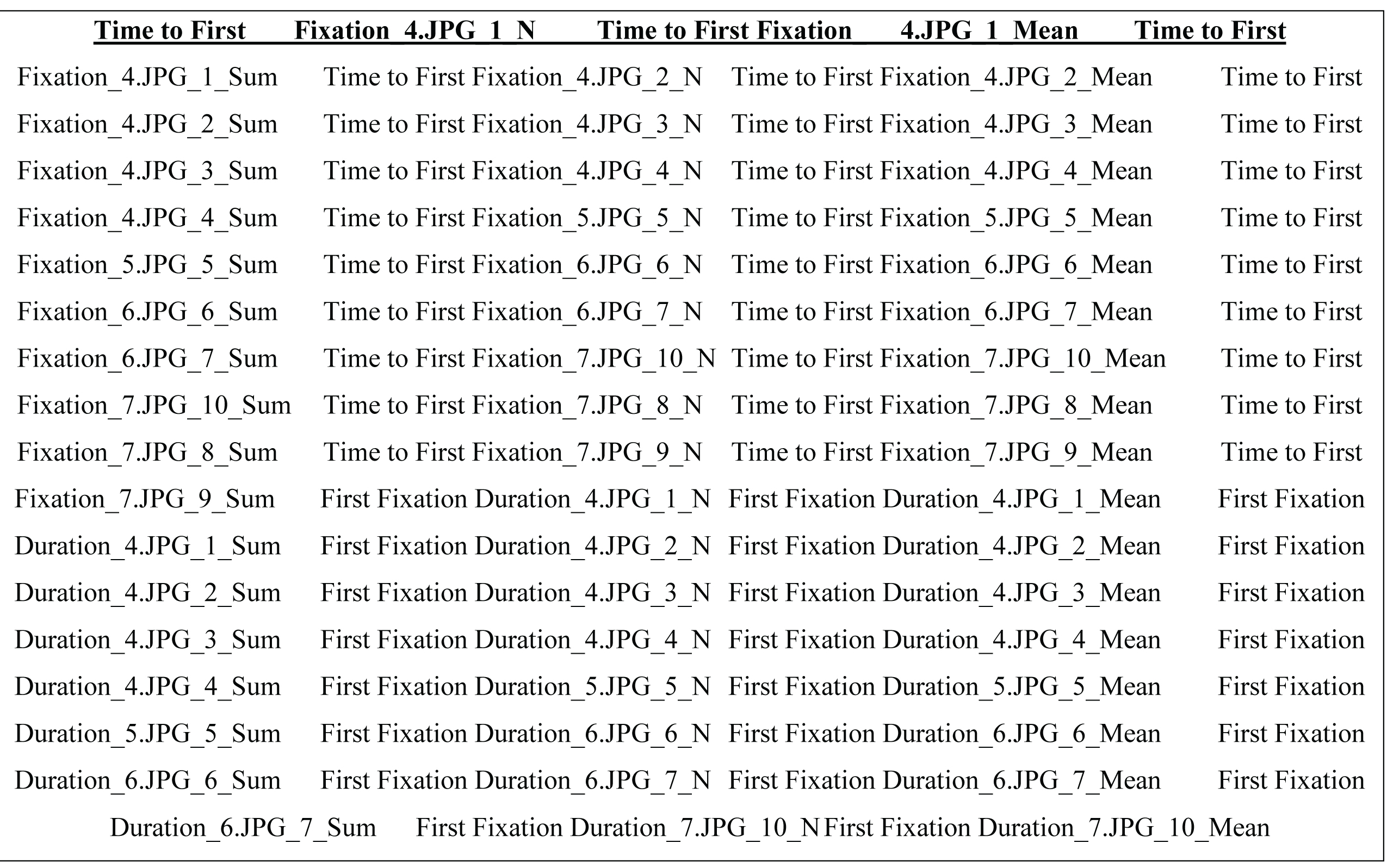
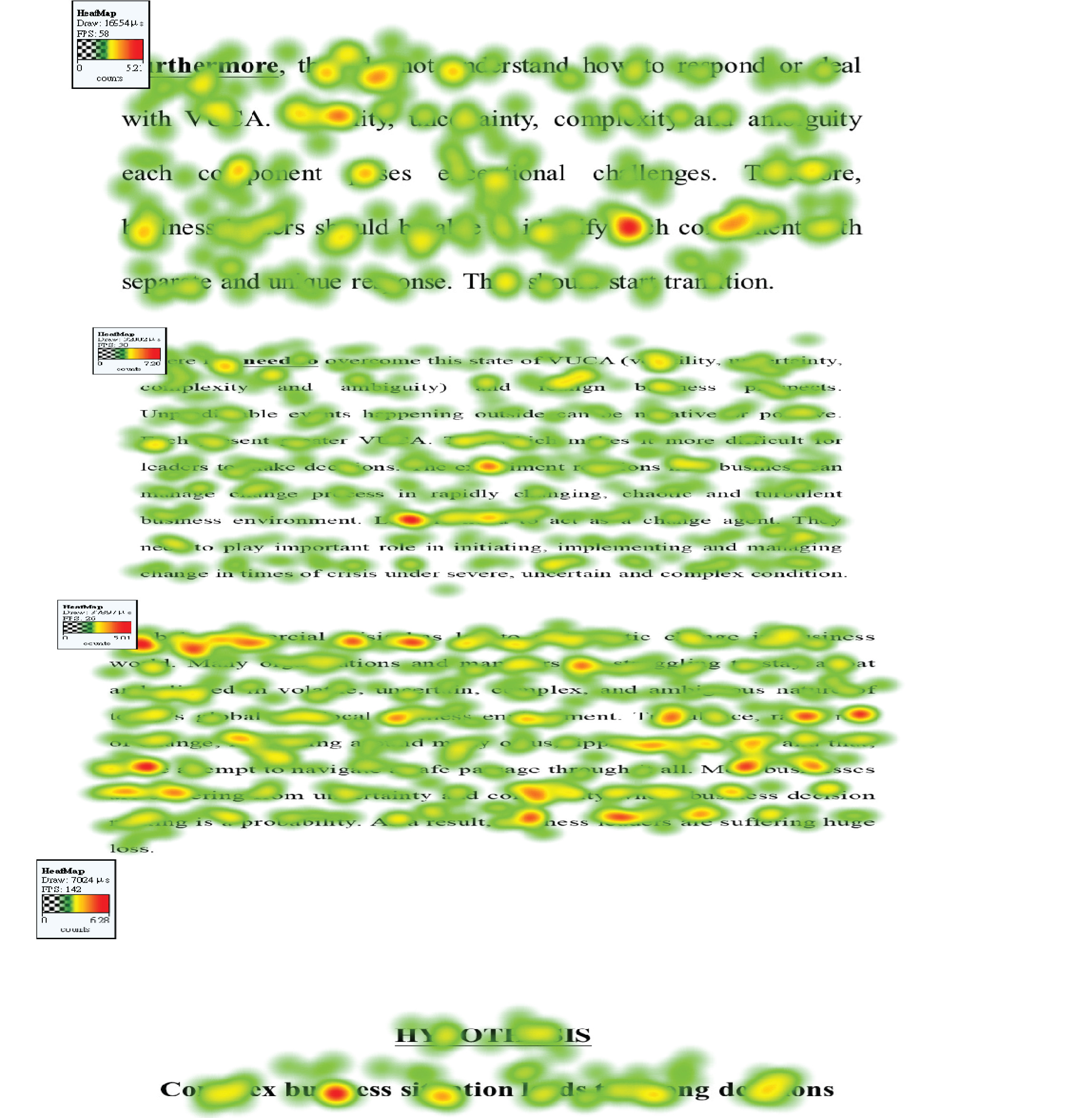
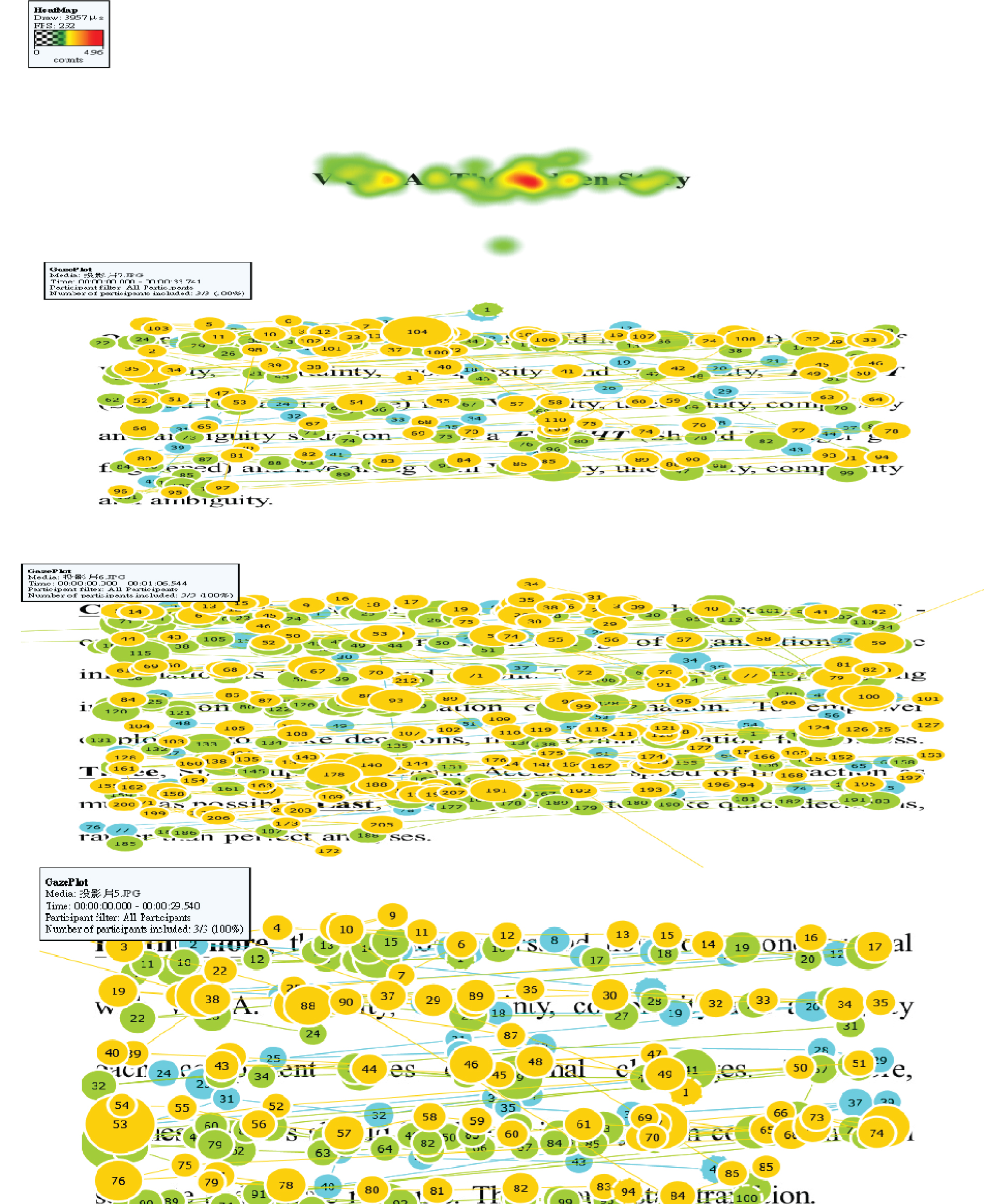
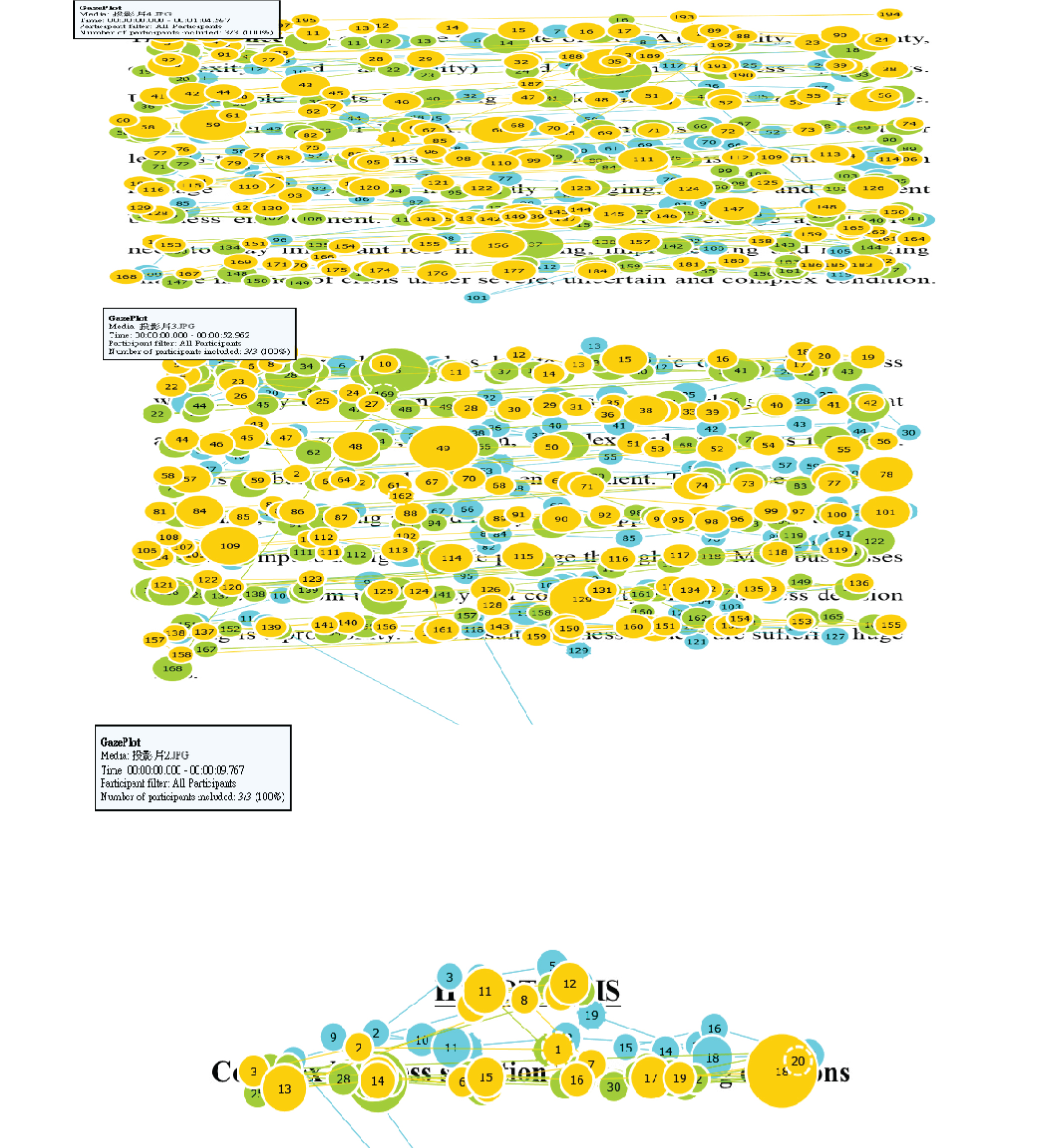
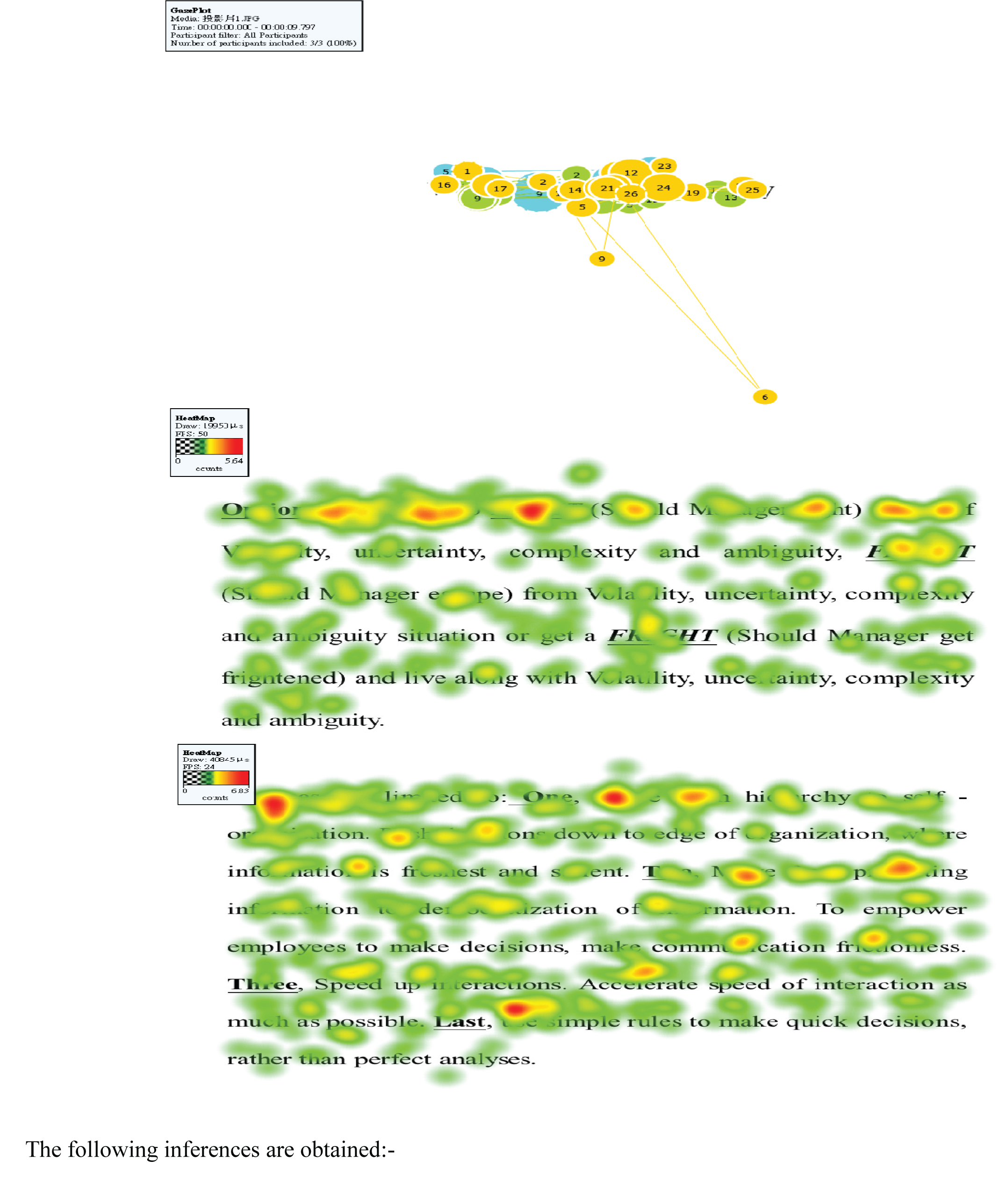
- Eye ‘tracking’ providespersuasive signal during technology based preference’ making process.
- Eye ‘tracking’ is recognised as a method to assess conception procedures in a technology - centered preference’ process.
- Separately from preference’ - task literalness and supposition elasticities, eye movements can be charted to examine technology oriented preference’ - approaches.
Practical Implications:
Managers delineate and process information through the activation of several neuro components. The activation of frontal cortex, orbitofrontal cortex, anterior cingulate cortex and ventromedial prefrontal cortex illustrates key features of ‘accelerationism’ business ‘choice preferential’’ thinking processes. This understanding may help interpret different ‘choice preference’-assortment styles as reactiveness and reactiveness and how the ‘cranial apparatus’ responds to elements such as risk perception, evaluation of strategic alternative, weighted schemes, and other heuristics generally used by managers in organizations. This helps broaden understanding of key features of ‘accelerationism ‘business ‘choice preferential’’ thinking processes and the possibility of training specific areas of ‘cranial apparatus’ to improve quality and effectiveness of managers ‘choice preference’.
The research exploration explains how neuro apparatuses explore managerial ‘business ‘choice preferential’’ thinking through analysis of biological basis of preferences and significant role of ‘neuronics’ in prototyping managerial neuro - based ‘business ‘choice preferential’ thinking trajectory. Results exhibit monikers for spontaneous counterfactual simulation in the domain of high - level cognition and illustrate how managers engage in ‘business ‘choice preferential’’ thinking using eye tracking techniques. These findings confirmed that explanation of neural signature cannot boil down to single network or few ‘cranial apparatus’ regions and suggest possible ways to guide eye tracking and how it is related to neuroscience and the ‘‘choice preference’ curve’. Major conclusion is that manager endeavours to address neuro - circuit using ‘neuro - drivers’. Conclusions offer opportunities for impending scholarships to increase on precise fragments of ‘choice preference’assortment practice during development stages. Moreover, specified the experimental nature of this paper, prospective exploration should test suppositions resulting from research schemes.Finally, this research exploration illustrates how ‘first - rate anchoring’ of eye tracking, ‘neuro - carters’, and ‘business ‘choice preferential’’ thinking trajectory’ can be implemented to explain how managers spot ‘business ‘choice preferential’’ thinking’.
‘Decisional’ thinking and choices define human beings. Do they have a basis in neurobiological, clinical, behavioural management and leadership? ‘Decisional’ thinking archetype is concerned with the perception underpinning an agent’s choices. If yes, then who serves as an agent? Are these networked computational neurologically (‘neural roulette’), in which the neurological basis underlies dynamics of ‘decisional’ thinking? What benchmark agent’s a preference or prospect attitude should fulfill in any universal settings. This amounts to of rationality. Do these represent sweeping renaissance of some primary concerns in understanding biology of ‘decisional’ thinking mechanisms? Computational neuromanagement (‘plotting computational neuronal - directed ‘decisional’ thinking trajectory’),has observed incredible advance since turn of this Century. Alongside cognito - management, it has made unequaled sensitivities into computational neuronal - focused substitutions that marshal behavioural investigation on business ‘actors’, ‘representations’ and ‘maxims’. With focus on computational neurotrajectory, Managers’ attempt at optimal computational neuro - based ‘decisional’ thinking via a trajectory till ‘response threshold’ is stretched. Cognito - management examines this ‘plotting’ by ‘cognito - tactical monikers’ (CTM) to probe how ‘cranial apparatus’ performs in journey of higher cognitive functions. ‘cranial apparatus’'s wiring diagram calls for need to identify ‘Carters’ (frontal cortex, orbitofrontal cortex, anterior cingulate cortex and ventromedial prefrontal cortex) that craft ‘managerial ‘decisional’ thinking mosaic’. Managerial decision making involves a complex computational neurobiological basis an emerging new paradigm, through ‘cranial apparatus’'s (behavior through lens of mental operations) wiring diagram, paper highlights potential cause - consequence linkage between biology and management in explaining how Managers deal in ‘accelerationism’ ‘decisional’ thinking dynamics. Current lack of success and effort necessary for validating models are traced to weak theoretical representation of managerial ‘accelerationism’ ‘decisional’ thinking making in current ‘edifice’. Attempt is to explore nature of causality, identify methods to test causal relations, employ empirical cognitive and neural approach (es) to causal reasoning and establish a relation between molecular and genetic causation and causality using hematological and molecular and genetic - management’ data to reveal neural paths in managerial ‘accelerationism’ and ‘decisional’ thinking making. A paradigmatic case of ‘crossbreeding’, this paper empirically tests behavioural experiment design via psychophysical approaches besides functional and fundamental imaging systems. Experimentation is advocated as best approach to deduce causal knowledge. Studies linking eye movements and other physiological concomitants are currently being used to measure thinking in real time, thanks largely to the invention of technology which allows for ‘cranial apparatus’ and physiology mapping in real time.
References
- Ashkanasy, N. M., Becker, W. J., and Waldman, D. A. (2014). Neuroscience and organizational behavior: Avoiding both neuro-euphoria and neuro-phobia. Journal of Organizational Behavior, 35(7), 909–919
- Baron, R. A., and Ward, T. B. (2004). Expanding entrepreneurial cognition’s toolbox: Potential contributions from the field of cognitive science. Entrepreneurship Theory and Practice, 28(6), 553–573.
- Baucus, D. A., Baucus, M. S., and Mitchell, R. K. (2014). Lessons from the neural foundation of entrepreneurial cognition: the case of emotion and motivation. Handbook of Entrepreneurial Cognition, 254-315.
- Entrepreneurship Theory and Practice Special Issue - Entrepreneurship and Biology. (n.d.). Retrieved March 3, 2019,
- Hackman, J. R., and Oldham, G. R. (1976). Motivation through the design of work: test of a theory. Organizational Behavior and Human Performance, 16(2), 250–279.
- Healey, M. P., and Hodgkinson, G. P. (2015). Toward a theoretical framework for organizational neuroscience. Organizational Neuroscience (Monographs in Leadership and Management, Volume 7), 51–81.
- Laureiro-Martínez, D., Canessa, N., Brusoni, S., Zollo, M., Hare, T., Alemanno, F., and Cappa, S. F. (2014). Frontopolar cortex and decision-making efficiency: comparing ‘cranial apparatus’ activity of experts with different professional background during an exploration-exploitation task. Frontiers in Human Neuroscience, 7, 927.
- Lerner, D. A., Hatak, I., and Rauch, A. (2018). Deep roots? Behavioral Inhibition and Behavioral Activation System (BIS/BAS) sensitivity and entrepreneurship. Journal of Business Venturing Insights, 9, 107–115.
- Martin de Holan, P., Ortiz-Terán, E., Turrero, A., and Alonso, T. O. (2013). Towards Neuroentrepreneurship? Early evidence from a neuroscience research exploration. Frontiers of Entrepreneurship Research, 33(5), 12.
- Nofal, A. M., Nicolaou, N., Symeonidou, N., and Shane, S. (2018). Biology and management: A review, critique, and research agenda. Journal of Management, 44(1), 7–31.
- Ortiz-Terán, E., A. Turrero, J. Santos, P. Bryant, T. Ortiz, and E. Ortiz-Terán (2013). ‘cranial apparatus’ cortical organization in entrepreneurs during a visual Stroop decision task. Neuroscience and Neuroeconomics, 2, 33–49.
- Rahmati, N., Rostami R., Zali M., Nowicki S., and Zarei J. (2014). The effectiveness of neurofeedback on enhancing cognitive process involved in entrepreneurship abilities among primary school students in district No. 3 Tehran. Basic and Clinical Neuroscience, 5(4), 277–84.
- Shepherd, D. A., and Patzelt, H. (2018). Entrepreneurial cognition: Exploring the mindset of entrepreneurs. Cham, Switzerland: Palgrave Macmillan.
- Waldman, D. A., Ward, M. K., and Becker, W. J. (2017). Neuroscience in organizational behavior. Annual Review of Organizational Psychology and Organizational Behavior, 4(1), 425–444.
- Ward, M. K., Volk, S., and Becker, W. J. (2015). An overview of organizational neuroscience. In D. A. Waldman and P. A. Balthazard (Eds.), Organizational neuroscience (Vol. 7, pp. 17–50). Bingley, UK: Emerald Group Publishing Limited.
- Zaro, M., da Cruz Fagundes, L., Rocha, F., and Nunes, W. (2016) .Cognitive ‘cranial apparatus’ mapping used in the research exploration of entrepreneurial behavior – pilot test with the use of electroencephalogram– EEG during the process of identification of business opportunities. American Journal of Educational Research, 4(6), 472–8.
